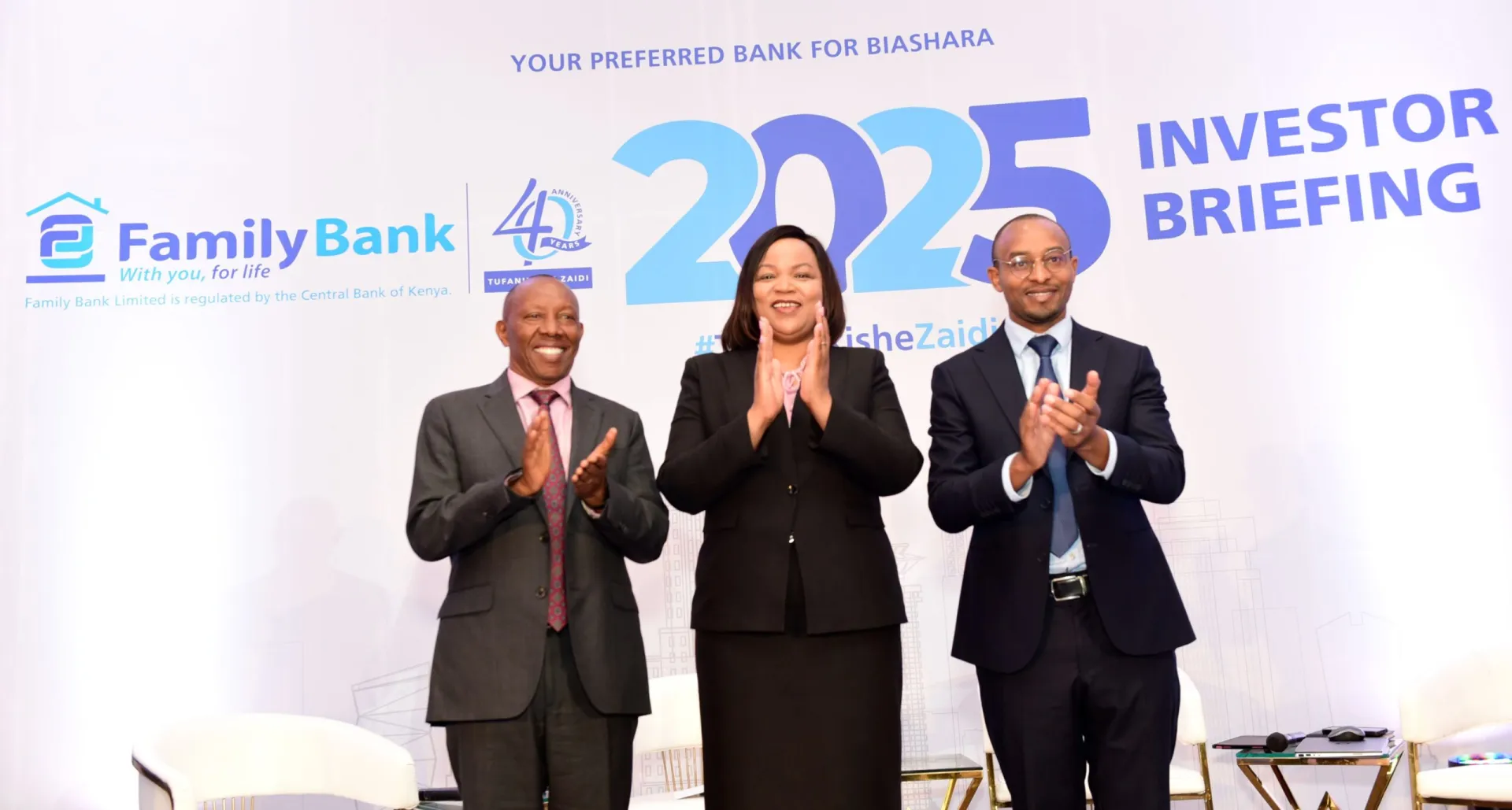Family Bank shareholders are preparing for a pivotal moment in the institution’s history as they gear up for an Extraordinary General Meeting (EGM) scheduled for October 27, 2025. The virtual meeting will determine whether the bank proceeds with listing its ordinary shares on the Nairobi Securities Exchange (NSE) by introduction, a move that could mark the first major bank listing in Kenya in several years and potentially revitalize the country’s capital markets.
Build the future you deserve. Get started with our top-tier Online courses: ACCA, HESI A2, ATI TEAS 7, HESI EXIT, NCLEX-RN, NCLEX-PN, and Financial Literacy. Let Serrari Ed guide your path to success. Enroll today.
Understanding the Listing by Introduction
The proposed listing by introduction represents a strategic approach that would allow Family Bank’s existing shares to trade publicly on the NSE without the need to raise new capital through a traditional initial public offering. This method offers several distinct advantages for both the bank and its current shareholders.
For shareholders who have been trading their stakes over-the-counter in private transactions, the listing will dramatically improve liquidity. Currently, selling shares in an unlisted company requires finding willing buyers privately, negotiating prices individually, and completing transactions without the benefit of a transparent market mechanism. Once listed, shareholders will be able to buy and sell their stakes easily through the exchange’s automated trading system, with prices determined by real-time supply and demand.
The listing will also enhance transparency through the NSE’s stringent reporting rules. As a publicly listed entity, Family Bank would be required to publish quarterly financial results, disclose material information promptly, and adhere to corporate governance standards mandated by the Capital Markets Authority. This increased transparency typically leads to greater investor confidence and can potentially improve the bank’s valuation over time.
Keeping the IPO Option Open
While the immediate proposal focuses on listing by introduction, Family Bank’s board has strategically left the door open for a traditional Initial Public Offering (IPO) if market conditions become more favorable. This flexible approach demonstrates prudent financial planning and responsiveness to market dynamics.
An IPO would enable the bank to raise fresh capital by issuing new shares to the public. Market analysts have noted that such a capital injection would significantly strengthen Family Bank’s financial foundation, providing resources for several strategic initiatives. The additional capital could support the bank’s ambitious regional expansion plans, fund investments in cutting-edge banking technology, and bolster its balance sheet to compete more effectively with Kenya’s largest financial institutions.
The decision to pursue an IPO would likely depend on several factors, including overall stock market performance, investor appetite for banking stocks, prevailing interest rates, and the bank’s specific capital needs at the time. Kenya’s equity market has experienced challenging conditions in recent years, with limited new listings and subdued investor enthusiasm, making timing crucial for any public offering.
Ambitious 2025-2029 Strategic Plan
Family Bank’s potential NSE listing is intrinsically linked to its comprehensive five-year strategic plan spanning 2025 to 2029. This bold roadmap outlines transformational changes designed to propel the bank into Kenya’s elite Tier 1 banking group by 2029, a goal that reflects both ambition and confidence in the institution’s capabilities.
Holding Company Structure
A cornerstone of the strategy involves transitioning to a holding company structure. This organizational model, increasingly popular among financial institutions globally, would position Family Bank as a subsidiary under a parent holding company. The structure offers several strategic advantages, including the ability to establish separate subsidiaries for different financial services such as insurance, asset management, or microfinance.
This model provides operational flexibility, ring-fences risks by separating different business lines, and facilitates easier regulatory compliance. It also makes it simpler to attract investment into specific subsidiaries and can enhance overall corporate governance. Several of Kenya’s largest banks, including KCB Group and Equity Group, have already adopted this model successfully.
Regional Expansion Plans
The strategy emphasizes aggressive regional growth across East and Central Africa, tapping into markets beyond Kenya’s borders. This expansion aligns with the trend among Kenyan banks to diversify revenue sources and reduce dependence on the domestic market, which has become increasingly competitive and saturated.
Regional expansion offers access to underbanked populations, higher interest rate margins in some markets, and opportunities to serve Kenyan businesses expanding across the continent. Countries like Uganda, Tanzania, Rwanda, and Democratic Republic of Congo present attractive growth prospects with their young populations, growing middle classes, and increasing financial inclusion rates.
However, regional expansion also brings challenges, including navigating different regulatory environments, understanding local market dynamics, managing currency risks, and competing with established local and international banks. Family Bank’s success in this endeavor will require careful market selection, appropriate entry strategies, and sufficient capital allocation.
Digital Transformation Investment
Recognizing that technology is reshaping the banking landscape, Family Bank has committed KSh 1 billion to investment in digital systems. This substantial allocation underscores the bank’s understanding that digital capabilities are no longer optional but essential for competitive survival.
The digital transformation investment will likely focus on several key areas. Enhanced mobile banking platforms are crucial, given Kenya’s leadership in mobile financial services and customer expectations for seamless digital experiences. The bank may also invest in core banking system upgrades to improve processing speed, scalability, and reliability.
Artificial intelligence and machine learning applications could enhance credit scoring, fraud detection, and customer service through chatbots. Advanced data analytics capabilities would enable better customer segmentation, personalized product offerings, and improved risk management. Investment in cybersecurity infrastructure is also critical given the rising sophistication of cyber threats facing financial institutions.
Additionally, the bank may develop or enhance API banking capabilities to facilitate integration with fintech partners, expand digital lending products, and invest in blockchain technology for faster, more secure transactions.
Strong Half-Year 2025 Performance
Family Bank’s push for an NSE listing comes from a position of financial strength, as evidenced by impressive half-year results for 2025 that demonstrate robust growth across key performance metrics.
Profitability Surge
The bank’s net profit surged by an impressive 39% to reach KSh 2.28 billion in the first half of 2025, compared to KSh 1.65 billion during the same period in the previous year. This substantial growth reflects improved operational efficiency, expanding customer base, and effective risk management.
Profit before tax was even more impressive at KSh 2.93 billion, compared to KSh 2.32 billion a year earlier, representing a 26% increase. The difference between profit before tax and net profit reflects the bank’s tax obligations, with corporate tax rates for banks in Kenya currently standing at 30%.
Revenue Growth
Interest income, which represents the bank’s primary revenue source from loans and securities investments, grew by 24% to reach KSh 11.39 billion. This growth was driven by two main components: a robust loan book of KSh 100.9 billion and securities holdings of KSh 3.4 billion.
The loan portfolio growth indicates increased lending activity, suggesting that Family Bank successfully attracted borrowers despite competitive pressures from other financial institutions and alternative lenders. The growth in loans typically reflects both new customer acquisition and expanded relationships with existing clients.
Non-interest income, which includes fees, commissions, and other income sources, rose by 18% to KSh 2.68 billion. This revenue stream is particularly important for banks as it provides diversification and is generally less capital-intensive than traditional lending. Sources of non-interest income include account maintenance fees, transaction charges, foreign exchange earnings, and commissions from bancassurance products.
Balance Sheet Expansion
Family Bank’s balance sheet showed healthy expansion, with customer deposits increasing by 26% to reach KSh 150.4 billion. This growth in deposits is particularly significant as it demonstrates customer confidence in the institution and provides the bank with relatively low-cost funding for its lending activities. In Kenya’s competitive banking environment, attracting and retaining deposits requires competitive interest rates, quality customer service, and convenient access channels.
Total assets grew by 22% to KSh 192.9 billion, reflecting the bank’s overall expansion and its ability to deploy additional resources productively. Asset growth that outpaces the industry average typically indicates market share gains and successful execution of growth strategies.
One decision can change your entire career. Take that step with our Online courses in ACCA, HESI A2, ATI TEAS 7, HESI EXIT, NCLEX-RN, NCLEX-PN, and Financial Literacy. Join Serrari Ed and start building your brighter future today.
Operational Metrics
Net interest income, representing the difference between interest earned on loans and securities and interest paid on deposits, reached KSh 6.95 billion, marking a 40% increase. This metric is crucial as it reflects the bank’s core profitability from its fundamental banking activities. The strong growth suggests effective interest rate management and a favorable mix of earning assets relative to interest-bearing liabilities.
However, operating expenses also grew significantly, increasing by 36% to KSh 6.71 billion. This rise reflects the costs associated with expansion, including staff salaries, branch operations, technology investments, and marketing expenses. While expense growth is natural during expansion phases, maintaining a healthy balance between revenue growth and expense control remains crucial for long-term profitability.
Loan loss provisions stood at KSh 664 million, representing the amount set aside to cover potential loan defaults. This prudent provisioning is essential for maintaining financial stability and complying with Central Bank of Kenya prudential guidelines.
Asset Quality Considerations
The bank’s gross non-performing loans (NPLs) increased to KSh 15.2 billion from KSh 14.1 billion, a development that warrants attention. However, net NPLs remained stable at KSh 3.4 billion, indicating that the bank has adequate provisions to cover potential losses from defaulted loans.
The non-performing loan ratio of 14.1% in early 2025, while below the banking sector’s average of 16%, remains elevated by international standards. This ratio indicates the percentage of the loan book where borrowers are not meeting their repayment obligations, and managing it downward will be important for the bank’s long-term health.
Elevated NPLs can result from various factors, including economic challenges affecting borrowers’ ability to repay, weaknesses in credit assessment processes, or concentration in sectors experiencing difficulties. Managing NPLs requires proactive monitoring, early intervention with struggling borrowers, and when necessary, recovery actions.
Capital and Liquidity Position
Family Bank maintains a solid capital position with a core capital ratio of 13.3%, comfortably above the regulatory minimum of 10.5% set by the Central Bank of Kenya. This cushion provides room for growth and demonstrates the bank’s ability to absorb potential losses without falling below regulatory requirements.
The bank’s liquidity position is exceptionally strong at 53.1%, significantly exceeding the 20% regulatory requirement. High liquidity indicates the bank’s ability to meet withdrawal demands and other short-term obligations, though holding excessive liquidity can also mean foregone opportunities to deploy funds in higher-yielding assets.
Risk Factors and Challenges
Despite the positive performance indicators, Family Bank faces several challenges that could impact its listing plans and future growth trajectory.
Efficiency Concerns
The cost-to-equity ratio exceeding 60% signals efficiency pressures that need addressing. This metric, which measures operating expenses relative to shareholders’ equity, suggests that the bank may need to optimize its cost structure to improve returns to shareholders. Addressing this could involve streamlining operations, automating more processes, or achieving greater economies of scale through growth.
Market Conditions
The appetite for new listings in Kenya’s equity market remains uncertain. The NSE has experienced challenging conditions with limited fresh entries in recent years, subdued trading volumes, and declining market capitalization. This environment could affect Family Bank’s listing reception and the valuation it might achieve.
Several factors have contributed to the market’s lackluster performance, including high interest rates making fixed-income investments more attractive, economic uncertainty affecting investor sentiment, governance concerns at some listed companies, and limited retail investor participation. For Family Bank’s listing to succeed, market conditions may need to improve or the bank may need to price its shares attractively to generate investor interest.
Competitive Landscape
Kenya’s banking sector remains highly competitive, with approximately 39 licensed banks competing for customers. The sector has been experiencing consolidation, with mergers and acquisitions reshaping the landscape. Family Bank will need to continue differentiating itself through superior customer service, innovative products, and strategic positioning to maintain its growth trajectory.
Implications for Kenya’s Capital Markets
If shareholders approve the listing proposal, Family Bank’s NSE entry would carry significant implications beyond the bank itself. As the first major bank listing in years, it could serve as a catalyst for reviving market activity and attracting renewed investor attention to Kenya’s equity market.
A successful listing might encourage other mid-tier lenders considering similar moves to proceed with their plans, potentially leading to a wave of new listings that would increase market depth and provide investors with more options. The listing could also demonstrate to private companies across various sectors that the NSE remains a viable avenue for accessing capital and enhancing shareholder value.
For Kenya’s financial sector, Family Bank’s listing would increase transparency and competition, potentially benefiting consumers through better services and more competitive pricing. The additional scrutiny that comes with being a publicly listed company often drives improvements in governance and operational efficiency.
The Road Ahead
The October 27, 2025, Extraordinary General Meeting represents a watershed moment for Family Bank and its stakeholders. Shareholders will weigh the benefits of improved liquidity and transparency against any concerns about increased regulatory scrutiny and market volatility.
If approved, the listing process would involve several steps, including obtaining regulatory approvals from the Capital Markets Authority and the NSE, finalizing listing particulars, appointing advisors such as sponsoring stockbrokers and legal counsel, and completing administrative requirements.
The entire process could take several months from approval to actual listing, during which the bank would need to maintain its performance momentum and ensure all regulatory requirements are met. Market conditions at the time of listing will significantly influence the reception and initial trading performance.
Conclusion
Family Bank stands at a crossroads, with the potential NSE listing representing both an opportunity and a challenge. The bank’s strong financial performance in the first half of 2025 provides a solid foundation for public market entry, while its ambitious strategic plan signals confidence in future growth.
The decision facing shareholders on October 27 will shape not only Family Bank’s future but could also influence the trajectory of Kenya’s capital markets. Investors, regulators, and market observers will be watching closely as this mid-tier lender seeks to join the ranks of publicly traded banks and pursue its goal of reaching Tier 1 status by 2029.
Whether through listing by introduction or a future IPO, Family Bank’s journey to the public markets reflects broader trends in Kenya’s financial sector, including consolidation, regional expansion, digital transformation, and the ongoing evolution of banking in East Africa. The outcome of this initiative will provide valuable lessons for other financial institutions considering similar paths and could mark the beginning of a new chapter for Kenya’s equity markets.
Ready to take your career to the next level? Join our Online courses: ACCA, HESI A2, ATI TEAS 7 , HESI EXIT , NCLEX – RN and NCLEX – PN, Financial Literacy!🌟 Dive into a world of opportunities and empower yourself for success. Explore more at Serrari Ed and start your exciting journey today! ✨
Track GDP, Inflation and Central Bank rates for top African markets with Serrari’s comparator tool.
See today’s Treasury bonds and Money market funds movement across financial service providers in Kenya, using Serrari’s comparator tools.
Photo source: Google
By: Montel Kamau
Serrari Financial Analyst
2nd October, 2025
Article, Financial and News Disclaimer
The Value of a Financial Advisor
While this article offers valuable insights, it is essential to recognize that personal finance can be highly complex and unique to each individual. A financial advisor provides professional expertise and personalized guidance to help you make well-informed decisions tailored to your specific circumstances and goals.
Beyond offering knowledge, a financial advisor serves as a trusted partner to help you stay disciplined, avoid common pitfalls, and remain focused on your long-term objectives. Their perspective and experience can complement your own efforts, enhancing your financial well-being and ensuring a more confident approach to managing your finances.
Disclaimer: This article is for informational purposes only and does not constitute financial advice. Readers are encouraged to consult a licensed financial advisor to obtain guidance specific to their financial situation.
Article and News Disclaimer
The information provided on www.serrarigroup.com is for general informational purposes only. While we strive to keep the information up to date and accurate, we make no representations or warranties of any kind, express or implied, about the completeness, accuracy, reliability, suitability, or availability with respect to the website or the information, products, services, or related graphics contained on the website for any purpose. Any reliance you place on such information is therefore strictly at your own risk.
www.serrarigroup.com is not responsible for any errors or omissions, or for the results obtained from the use of this information. All information on the website is provided on an as-is basis, with no guarantee of completeness, accuracy, timeliness, or of the results obtained from the use of this information, and without warranty of any kind, express or implied, including but not limited to warranties of performance, merchantability, and fitness for a particular purpose.
In no event will www.serrarigroup.com be liable to you or anyone else for any decision made or action taken in reliance on the information provided on the website or for any consequential, special, or similar damages, even if advised of the possibility of such damages.
The articles, news, and information presented on www.serrarigroup.com reflect the opinions of the respective authors and contributors and do not necessarily represent the views of the website or its management. Any views or opinions expressed are solely those of the individual authors and do not represent the website's views or opinions as a whole.
The content on www.serrarigroup.com may include links to external websites, which are provided for convenience and informational purposes only. We have no control over the nature, content, and availability of those sites. The inclusion of any links does not necessarily imply a recommendation or endorsement of the views expressed within them.
Every effort is made to keep the website up and running smoothly. However, www.serrarigroup.com takes no responsibility for, and will not be liable for, the website being temporarily unavailable due to technical issues beyond our control.
Please note that laws, regulations, and information can change rapidly, and we advise you to conduct further research and seek professional advice when necessary.
By using www.serrarigroup.com, you agree to this disclaimer and its terms. If you do not agree with this disclaimer, please do not use the website.
www.serrarigroup.com, reserves the right to update, modify, or remove any part of this disclaimer without prior notice. It is your responsibility to review this disclaimer periodically for changes.
Serrari Group 2025












